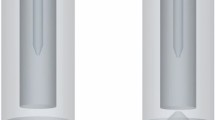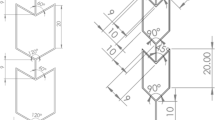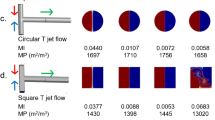Abstract
A novel tube-in-tube millireactor with multiholes jet and twist tapes was designed and investigated for its excellent mixing, low price, and industrialization prospects. The inner tube fluid jets into the annular space through six circular microholes with a diameter of 0.2 mm that are evenly drilled around the inner tube. This arrangement achieves good inlet dispersion. The annular reaction channel is modified by three types of twist tape, which facilitates fluid splitting, recombination, and swirling. A detailed computational study has been carried out on the millireactor to characterize flow using a verified and validated CFD model. Villermaux-Dushman reaction and impulse method residence time distribution were used to study both the micromixing and macromixing performance. The multiholes jet has excellent micro-mixing performance with a micro-mixing time of less than 1 ms, at Re > 350. The twist tapes effectively improve the macromixing so that a Pe > 100 is achieved in most of the range of Re 32 ~ 634. Local flow field visualization of the annular spaces with tapes is obtained by PIV - RIM, and the results align with the CFD model.
Graphical Abstract

Highlights
A novel tube-in-tube millireactor with multiholes jet and twist tapes was designed with excellent micromixing and narrow RTD.
Micromixing time is less than 1ms, at Re > 350.
Pe > 100 in most of the studied range, V = 6 ~ 240 ml/min.
The local flow field was obtained by PIV-RIM under structure shading.
The micromixing and differential pressure between inner and outer tube are determined by \({Re}_{hole}\).





















Similar content being viewed by others
Abbreviations
- CFD :
-
Computational Fluid Dynamics
- C j :
-
reactant concentration of species j, mol/L
- C j,r :
-
molar concentration of species j in reaction r, mol/L
- C j10 :
-
concentration of the surrounding fluid, mol/L
- d hole :
-
microhole size, mm
- d N :
-
hydrodynamic diameter
- E(t) :
-
exit age distribution as a function of time, s− 1
- E(θ) :
-
exit age distribution as a function of dimensionless time
- f :
-
friction coefficient
- L :
-
length of the reactor channel, mm
- M :
-
parameter in empirical model
- N :
-
parameter in empirical model
- N in :
-
Molar amount of substance in the inner tube
- N out :
-
Molar amount of substance in the outter tube
- P:
-
pitch,mm
- Pe :
-
reactor Peclet number, also known as Bodenstein number. The reciprocal is referred to as the Vessel Dispersion number
- PIV :
-
Particle Image Velocimetry
- PLIF :
-
Planer Laser Induced Fluorescence
- R :
-
the ratio of the volume flow between the inner and outer tubes
- RI :
-
Refraction index
- Re :
-
Reynolds number
- TKE :
-
turbulent kinetic energy, m2/s2
- t m :
-
characteristic micromixing time, s
- t max :
-
maximum residence time
- t min :
-
minimum residence time
- \(\overline{t}\) :
-
mean residence time, s
- V in :
-
volume flow rate in inner tube, ml/min
- V out :
-
volume flow rate in outter tube, ml/min
- X s :
-
segregation index
- ΔP :
-
fluid pressure drop, Pa
- ε:
-
turbulent dissipation rate, m2/s3.
- μ :
-
viscosity, Pa s.
- τ :
-
nominal space time, s.
- \({\sigma ^2}\) :
-
variance
- \(\sigma _{\theta }^{2}\) :
-
dimensionless variance
References
Besenhard MO, LaGrow AP, Hodzic A, Kriechbaum M, Panariello L, Bais G, Loizou K, Damilos S, Cruz MM, Thanh NTK, Gavriilidis A (2020) Co-precipitation synthesis of stable iron oxide nanoparticles with NaOH: New insights and continuous production via flow chemistry. Chem Eng J 399
Rossetti I, Compagnoni M (2016) Chemical reaction engineering, process design and scale-up issues at the frontier of synthesis: Flow chemistry. Chem Eng J 296:56–70
Bieringer T, Buchholz S, Kockmann N (2013) Future production concepts in the chemical industry: Modular - Small-Scale - Continuous. Chem Eng Technol 36(6):900–910
Berton M, de Souza JM, Abdiaj I, McQuade DT, Snead DR (2020) Scaling continuous API synthesis from milligram to kilogram: extending the enabling benefits of micro to the plant. J Flow Chem 10(1):73–92
Roberge DM, Ducry L, Bieler N, Cretton P, Zimmermann B (2005) Microreactor technology: A revolution for the fine chemical and pharmaceutical industries? Chem Eng Technol 28(3):318–323
Hessel V (2009) Process windows - gate to maximizing process intensification via flow chemistry. Chem Eng Technol 32(11):1655–1681
Gauthier DR, Sherry BD, Cao Y, Journet M, Humphrey G, Itoh T, Mangion I, Tschaen DM (2015) Highly efficient synthesis of hiv nnrti doravirine. Org Lett 17(6):1353–1356
Hessel V, Kralisch D, Kockmann N, Noel T, Wang Q (2013) Novel process windows for enabling, accelerating, and uplifting flow chemistry. Chemsuschem 6(5):746–789
Hessel V, Kralisch D, Kockmann N (2015) Novel Process Windows: Innovative gates to intensified and sustainable chemical processes. Wiley-VCH Verlag, Hoboken, pp 1–314
Roberge DM, Gottsponer M, Eyholzer M, Kockmann N (2009) Industrial design, scale-up, and use of microreactors. Chim Oggi-Chem Today 27(4):8–11
Kockmann N, Gottsponer M, Roberge DM (2011) Scale-up concept of single-channel microreactors from process development to industrial production. Chem Eng J167(2–3):718–726
Schwolow S, Neumüller A, Abahmane L, Kockmann N, Röder T (2016) Design and application of a millistructured heat exchanger reactor for an energy-efficient process. Chem Eng Process 108:109–116
Schwolow S, Mutsch B, Kockmann N, Röder T (2019) Model-based scale-up and reactor design for solvent-free synthesis of an ionic liquid in a millistructured flow reactor. React Chem Eng 4(3):523–536
Plutschack MB, Pieber B, Gilmore K, Seeberger PH (2017) The Hitchhiker’s guide to flow chemistry. Chem Rev 117(18):11796–11893
Han S, Kashfipour MA, Ramezani M, Abolhasani M (2020) Accelerating gas-liquid chemical reactions in flow. Chem Commun 56(73):10593–10606
Su Y, Lautenschleger A, Chen G, Kenig EY (2014) A numerical study on liquid mixing in multichannel micromixers. Ind Eng Chem Res 53(1):390–401
Engler M, Kockmann N, Kiefer T, Woias P (2004) Numerical and experimental investigations on liquid mixing in static micromixers. Chem Eng J 101(1–3):315–322
Kockmann N, Kiefer T, Engler M, Woias P (2006) Silicon microstructures for high throughput mixing devices. Microfluid Nanofluid 2(4):327–335
Singh J, Kockmann N, Nigam KDP (2014) Novel three-dimensional microfluidic device for process intensification. Chem Eng Process-Process Intensif 86:78–89
Dong C, Zhang JS, Wang K, Luo GS (2014) Micromixing performance of nanoparticle suspensions in a micro-sieve dispersion reactor. Chem Eng J 253:8–15
Zhang JS, Wang K, Lu YC, Luo GS (2010) Characterization and modeling of micromixing performance in micropore dispersion reactors. Chem Eng Process 49(7):740–747
Commenge JM, Falk L (2011) Villermaux-Dushman protocol for experimental characterization of micromixers. Chem Eng Process 50(10):979–990
Suryawanshi PL, Gumfekar SP, Bhanvase BA, Sonawane SH, Pimplapure MS (2018) A review on microreactors: Reactor fabrication, design, and cutting-edge applications. Chem Eng Sci 189:431–448
Silva JLd, Santana HS (2022) Residence time distribution in reactive and non-reactive flow systems in micro and millidevices. Chem Eng Sci 248:117163
Kurt SK, Gelhausen MG, Kockmann N (2015) Axial dispersion and heat transfer in a milli/microstructured coiled flow inverter for narrow residence time distribution at laminar flow. Chem Eng Technol 38(7):1122–1130
Klutz S, Kurt SK, Lobedann M, Kockmann N (2015) Narrow residence time distribution in tubular reactor concept for Reynolds number range of 10–100. Chem Eng Res Des 95:22–33
Hopley A, Doyle BJ, Roberge DM, Macchi A (2019) Residence time distribution in coil and plate micro-reactors. Chem Eng Sci 207:181–193
Gobert SRL, Kuhn S, Braeken L, Thomassen LCJ (2017) Characterization of milli- and microflow reactors: mixing efficiency and residence time distribution. Org Process Res Dev 21(4):531–542
Ahmed SMR, Phan AN, Harvey AP (2017) Scale-up of oscillatory helical baffled reactors based on residence time distribution. Chem Eng Technol 40(5):907–914
Siguemoto ES, Leite Reche L, Gut JAW, Palma MSA (2020) Residence time distribution of a capillary microreactor used for pharmaceutical synthesis. Chem Eng Technol 43(3):429–435
Boskovic D, Loebbecke S (2008) Modelling of the residence time distribution in micromixers. Chem Eng J 135:S138–S146
Kurnia JC, Chaedir BA, Sasmito AP (2020) Laminar convective heat transfer in helical tube with twisted tape insert. Int J Heat Mass Transf 150:119309
Ahmad S, Abdullah S, Sopian K (2020) A review on the thermal performance of nanofluid inside circular tube with twisted tape inserts. Adv Mech Eng 12(6):1687814020924893
Piriyarungrod N, Eiamsa-ard S, Thianpong C, Pimsarn M, Nanan K (2015) Heat transfer enhancement by tapered twisted tape inserts. Chem Eng Process-Process Intensif 96:62–71
Huang F, Chen P, Wang J, Li Z, Gao Z, Derksen JJ (2020) Refractive index-matched PIV experiments and CFD simulations of mixing in a complex dynamic geometry. Ind Eng Chem Res 59(16):7982–7992
Xiong Q-Q, Chen Z, Li S-W, Wang Y-D, Xu J-H (2018) Micro-PIV measurement and CFD simulation of flow field and swirling strength during droplet formation process in a coaxial microchannel. Chem Eng Sci 185:157–167
Liu Z, Zhang L, Pang Y, Wang X, Li M (2017) Micro-PIV investigation of the internal flow transitions inside droplets traveling in a rectangular microchannel. Microfluid Nanofluid 21:12
Wright SF, Zadrazil I, Markides CN (2017) A review of solid–fluid selection options for optical-based measurements in single-phase liquid, two-phase liquid–liquid and multiphase solid–liquid flows. Exp Fluids 58(9):1–39
Li W, Xia F, Zhao S, Guo J, Zhang M, Li W, Zhang J (2019) Mixing performance of an inline high-shear mixer with a novel pore-array liquid distributor. Ind Eng Chem Res 58(44):20213–20225
Ansys I (2018) ANSYS fluent theory guide, release 19.1. ANSYS Inc, Canonsburg
Li W, Xia F, Qin H, Zhang M, Li W, Zhang J (2019) Numerical and experimental investigations of micromixing performance and efficiency in a pore-array intensified tube-in-tube microchannel reactor. Chem Eng J 370:1350–1365
Sung MK, Mudawar I (2008) Effects of jet pattern on single-phase cooling performance of hybrid micro-channel/micro-circular-jet-impingement thermal management scheme. Int J Heat Mass Transf 51(19–20):4614–4627
Sagot B, Antonini G, Christgen A, Buron F (2008) Jet impingement heat transfer on a flat plate at a constant wall temperature. Int J Therm Sci 47(12):1610–1619
Baydar E (1999) Confined impinging air jet at low Reynolds numbers. Exp Thermal Fluid Sci 19(1):27–33
Nawani S, Subhash M (2021) In A review on multiple liquid jet impingement onto flat plate. International Conference on Technological Advancements in Materials Science and Manufacturing (ICTAMSM), India, Feb 19–20; India, pp 11190–11197
Fogler HS (2016) Elements of chemical reaction engineering (5th). Pearson Education Inc, Boston
Ham JH, Platzer B (2004) Semi-empirical equations for the residence time distributions in disperse systems - Part 1: continuous phase. Chem Eng Technol 27(11):1172–1178
Krupa K, Nunes MI, Santos RJ, Bourne JR (2014) Characterization of micromixing in T-jet mixers. Chem Eng Sci 111:48–55
Villermaux J, Falk L (1994) A generalized mixing model for initial contacting of reactive fluids. Chem Eng Sci 49(24):5127–5140
Bałdyga J (1994) A closure model for homogeneous chemical reactions. Chem Eng Sci 49(12):1985–2003
Baldyga J, Bourne J (1989) Simplification of micromixing calculations. I. Derivation and application of new model. Chem Eng J 42(2):83–92
Baldyga J, Bourne J (1988) Calculation of micromixing in homogeneous stirred tank reactors. Chem Eng Res Des 66(1):33–38
Villermaux J, David R (1983) Recent advances in the understanding of micromixing phenomena in stirred reactors. Chem Eng Commun 21(1–3):105–122
Villermaux J, Devillon JC (1972) Représentation de la coalescence et de la redispersion des domaines de ségrégation dans un fluide par un modèle d’interaction phénoménologique. Proceedings of the Second International Symposium on Chemical Reaction Engineering, 1–13
Su Y, Chen G, Yuan Q (2011) Ideal micromixing performance in packed microchannels. Chem Eng Sci 66(13):2912–2919
Rahimi M, Valeh-e-Sheyda P, Parsamoghadam MA, Azimi N, Abidi H (2014) LASP and Villermaux/Dushman protocols for mixing performance in microchannels: Effect of geometry on micromixing characterization and size reduction. Chem Eng Process 85:178–186
Rahimi M, Aghel B, Hatamifar B, Akbari M, Alsairafi A (2014) CFD modeling of mixing intensification assisted with ultrasound wave in a T-type microreactor. Chem Eng Process 86:36–46
Fang JZ, Lee DJ (2001) Micromixing efficiency in static mixer. Chem Eng Sci 56(12):3797–3802
Mielke E, Plouffe P, Mongeon SS, Aellig C, Filliger S, Macchi A, Roberge DM (2018) Micro-reactor mixing unit interspacing for fast liquid-liquid reactions leading to a generalized scale-up methodology. Chem Eng J 352:682–694
Schikarski T, Trzenschiok H, Peukert W, Avila M (2019) Inflow boundary conditions determine T-mixer efficiency. Reaction Chem Eng 4(3):559–568
Levenspiel O (1998) Chemical reaction engineering. Wiley, Hoboken
Adeosun JT, Lawal A (2009) Numerical and experimental studies of mixing characteristics in a T-junction microchannel using residence-time distribution. Chem Eng Sci 64(10):2422–2432
Kumar V, Shirke V, Nigam KDP (2008) Performance of Kenics static mixer over a wide range of Reynolds number. Chem Eng J 139(2):284–295
Galaktionov OS, Anderson PD, Peters GWM, Meijer HEH (2003) Analysis and optimization of kenics static mixers. Int Polym Proc 18(2):138–150
Acknowledgements
This research is funded by Jiangsu Seven Continents Green Chemical Co., Ltd.
Author information
Authors and Affiliations
Contributions
Conceptualization; methodology; CFD simulation, validation, formal analysis, writing—original draft preparation, writing-review and editing, Hanyang Liu.; supervision, Junan Jiang, Ning Yang; project administration, Rijie Wang. All authors have read and agreed to the published version of the manuscript.
Corresponding author
Ethics declarations
Conflict of interest
The authors declare no competing financial interest.
Additional information
Publisher’s Note
Springer Nature remains neutral with regard to jurisdictional claims in published maps and institutional affiliations.
Supplementary Information
Below is the link to the electronic supplementary material.
Supporting information is available on the mesh independence and algorithm reliable verification, refractive index matching PIV, and The Villermaux–Dushman system.
ESM 1
(DOCX 132 KB)
Rights and permissions
About this article
Cite this article
Liu, H., Jiang, J., Yang, N. et al. Flow and mixing in a tube-in-tube millireactor with multiholes jet and twist tapes. J Flow Chem 12, 353–369 (2022). https://doi.org/10.1007/s41981-022-00232-2
Received:
Accepted:
Published:
Issue Date:
DOI: https://doi.org/10.1007/s41981-022-00232-2




